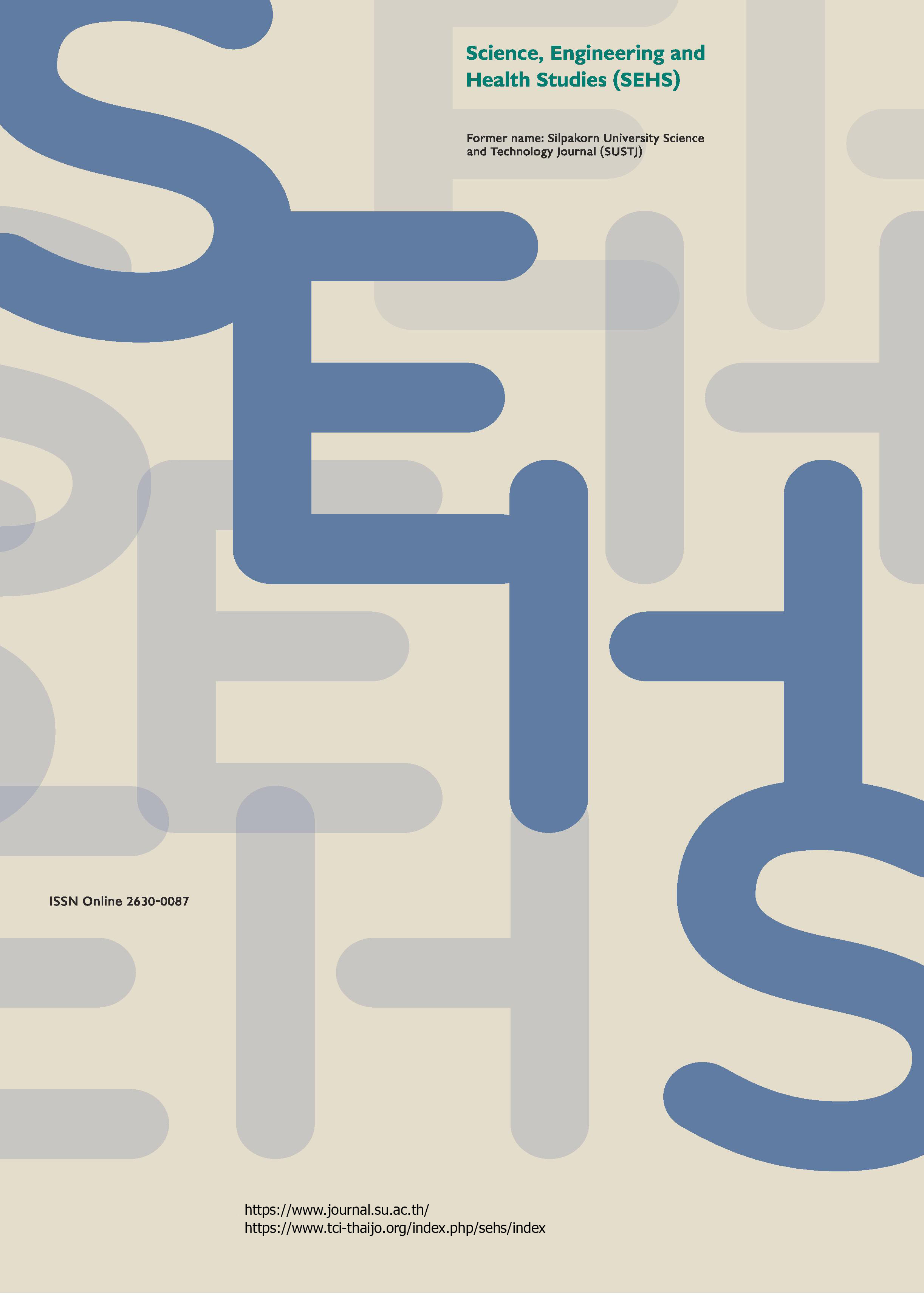Design and manufacture of gelatin-alginate scaffolds for tissue engineering based on three-dimensional extrusion bioprinting
Main Article Content
Abstract
Scaffolds play an important role in tissue engineering because they can provide the framework for cell proliferation, tissue creation, and organ regeneration. In this study, we used extrusional three-dimensional (3D) bioprinting technology to generate three scaffolds from gelatin, alginate, and CaCl2, where F6 was a scaffold made from 10% gelatin, 10% alginate, and 60 mM CaCl2; F7 was a scaffold made from 10% gelatin, 10% alginate, and 70 mM CaCl2; and F8 was a scaffold made from 10% gelatin, 10% alginate, and 80 mM CaCl2. They were crosslinked with CaCl2 at 100 mM, aiming to enhance their stiffness. The 3D-printed scaffolds were evaluated for four properties: mechanical testing, FTIR analysis, in vitro cytotoxicity, and cell viability. The results showed that the stiffness of the F8 scaffold was the greatest compared with the other two scaffolds. In general, the crosslinked scaffolds were better than the uncrosslinked scaffolds. For in vitro cytotoxicity test, all the scaffolds showed non-cytotoxic. Moreover, cell viability within the scaffolds printed from cell-laden bio-inks was observed 24 hours after printing and returning to culture conditions. Designing and generating 3D-printed scaffolds is fundamental to future research applications in tissue engineering.
Downloads
Article Details

This work is licensed under a Creative Commons Attribution-NonCommercial-NoDerivatives 4.0 International License.
References
Afewerki, S., Sheikhi, A., Kannan, S., Ahadian, S., and Khademhosseini, A. (2019). Gelatin‐polysaccharide composite scaffolds for 3D cell culture and tissue engineering: Towards natural therapeutics. Bioengineering & Translational Medicine, 4(1), 96−115.
Alizadeh-Osgouei, M., Li, Y., and Wen, C. (2019). A comprehensive review of biodegradable synthetic polymer-ceramic composites and their manufacture for biomedical applications. Bioactive Materials, 4, 22−36.
An, J., Teoh, J. E. M., Suntornnond, R., and Chua, C. K. (2015). Design and 3D printing of scaffolds and tissues. Engineering, 1(2), 261−268.
Benwood, C., Chrenek, J., Kirsch, R. L., Masri, N. Z., Richards, H., Teetzen, K., and Willerth, S. M. (2021). Natural biomaterials and their use as bioinks for printing tissues. Bioengineering, 8(2), 27.
Bose, S., Ke, D., Sahasrabudhe, H., and Bandyopadhyay, A. (2018). Additive manufacturing of biomaterials. Progress in Materials Science, 93, 45−111.
Daemi, H., and Barikani, M. (2012). Synthesis and characterization of calcium alginate nanoparticles, sodium homopolymannuronate salt and its calcium nanoparticles. Scientia Iranica, 19(6), 2023−2028.
Datta, S., Barua, R., and Das, J. (2020). Importance of alginate bioink for 3D bioprinting in tissue engineering and regenerative medicine. In Alginates-Recent Uses of This Natural Polymer (Pereira, L., Cotas, J., Blumenberg, M., Eds.), pp. 1−11. London: IntechOpen.
Fernandes, R. d. S., de Moura, M. R., Glenn, G. M., and Aouada, F. A. (2018). Thermal, microstructural, and spectroscopic analysis of Ca2+ alginate/clay nanocomposite hydrogel beads. Journal of Molecular Liquids, 265, 327−336.
GhavamiNejad, A., Ashammakhi, N., Wu, X. Y., and Khademhosseini, A. (2020). Crosslinking strategies for 3D bioprinting of polymeric hydrogels. Small, 16(35), 2002931.
Giuseppe, M. D., Law, N., Webb, B., Macrae, R. A., Liew, L. J., Sercombe, T. B., Dilley, R. J., and Doyle, B. J. (2018). Mechanical behaviour of alginate-gelatin hydrogels for 3D bioprinting. Journal of The Mechanical Behavior of Biomedical Materials, 79, 150−157.
Gopinathan, J., and Noh, I. (2018). Recent trends in bioinks for 3D printing. Biomaterials Research, 22(11), 1−15.
Haider, A., Waseem, A., Karpukhina, N., and Mohsin, S. (2020). Strontium-and zinc-containing bioactive glass and alginates scaffolds. Bioengineering, 7(1), 10.
Thangaraju, P., and Varthya, S. B. (2022). ISO 10993: Biological evaluation of medical devices. In Medical Device Guidelines and Regulations Handbook (Shanmugam, P. S. T., Thangaraju, P., Palani, N., and Sampath, T., Eds.), (pp. 163-187). Cham: Springer.
Klouda, L., and Mikos, A. G. (2008). Thermoresponsive hydrogels in biomedical applications. European Journal of Pharmaceutics and Biopharmaceutics, 68(1), 34−45.
Nelson, C., Tuladhar, S., Launen, L., and Habib, A. (2021). 3D bio-printability of hybrid pre-crosslinked hydrogels. International Journal of Molecular Sciences, 22(24), 13481.
Pan, T., Song, W., Cao, X., and Wang, Y. (2016). 3D bioplotting of gelatin/alginate scaffolds for tissue engineering: Influence of crosslinking degree and pore architecture on physicochemical properties. Journal of Materials Science & Technology, 32(9), 889−900.
Piras, C. C., and Smith, D. K. (2020). Multicomponent polysaccharide alginate-based bioinks. Journal of Materials Chemistry B, 8(36), 8171−8188.
Ramiah, P., du Toit, L. C., Choonara, Y. E., Kondiah, P. P., and Pillay, V. (2020). Hydrogel-based bioinks for 3D bioprinting in tissue regeneration. Frontiers in Materials, 7, 76.
Roi, A., Ardelean, L. C., Roi, C. I., Boia, E.-R., Boia, S., and Rusu, L.-C. (2019). Oral bone tissue engineering: Advanced biomaterials for cell adhesion, proliferation and differentiation. Materials, 12(14), 2296.
Rottensteiner, U., Sarker, B., Heusinger, D., Dafinova, D., Rath, S. N., Beier, J. P., Kneser, U., Horch, R. E., Detsch, R., Boccaccini, A. R., and Arkudas, A. (2014). In vitro and in vivo biocompatibility of alginate dialdehyde/gelatin hydrogels with and without nanoscaled bioactive glass for bone tissue engineering applications. Materials, 7(3), 1957−1974.
Sahoo, D. R., and Biswal, T. (2021). Alginate and its application to tissue engineering. SN Applied Sciences, 3(1), 30.
Somasekharan, L., Kasoju, N., Raju, R., and Bhatt, A. (2020). Formulation and characterization of alginate dialdehyde, gelatin, and platelet-rich plasma-based bioink for bioprinting applications. Bioengineering, 7(3), 108.
Tan, J. J. Y., Lee, C. P., and Hashimoto, M. (2020). Preheating of gelatin improves its printability with transglutaminase in direct ink writing 3D printing. International Journal of Bioprinting, 6(4), 296.
Unagolla, J. M., and Jayasuriya, A. C. (2020). Hydrogel-based 3D bioprinting: A comprehensive review on cell-laden hydrogels, bioink formulations, and future perspectives. Applied Materials Today, 18, 100479.
Vitus, V., Ibrahim, F., and Zaman, W. S. W. K. (2021). Modelling of stem cells microenvironment using carbon-based scaffold for tissue engineering application−A review. Polymers, 13(23), 4058.
You, F., Wu, X., and Chen, X. (2017). 3D printing of porous alginate/gelatin hydrogel scaffolds and their mechanical property characterization. International Journal of Polymeric Materials and Polymeric Biomaterials, 66(6), 299−306.
Zhang, X., Wang, X., Fan, W., Liu, Y., Wang, Q., and Weng, L. (2022). Fabrication, property and application of calcium alginate fiber: A review. Polymers, 14(15), 3227.


